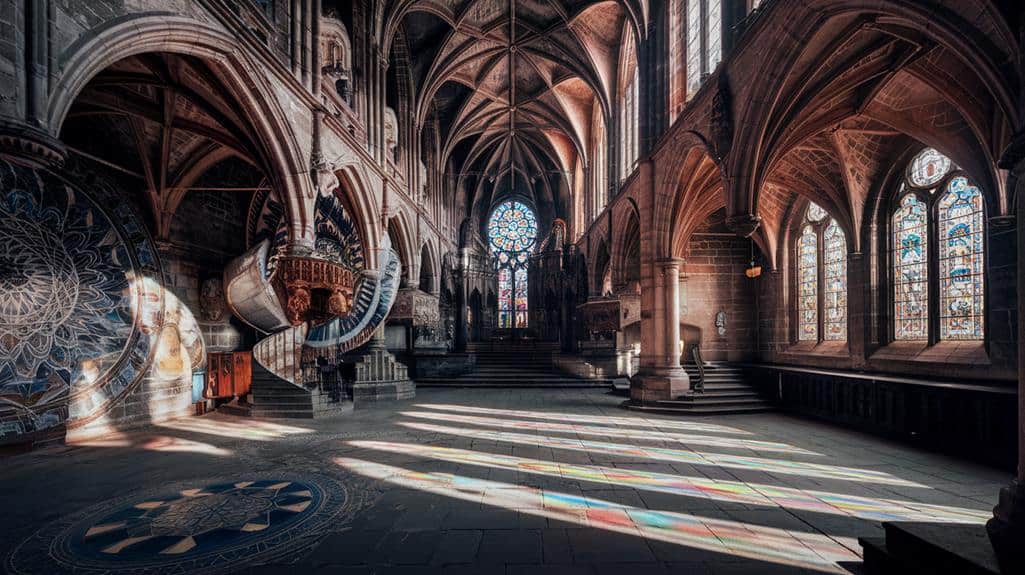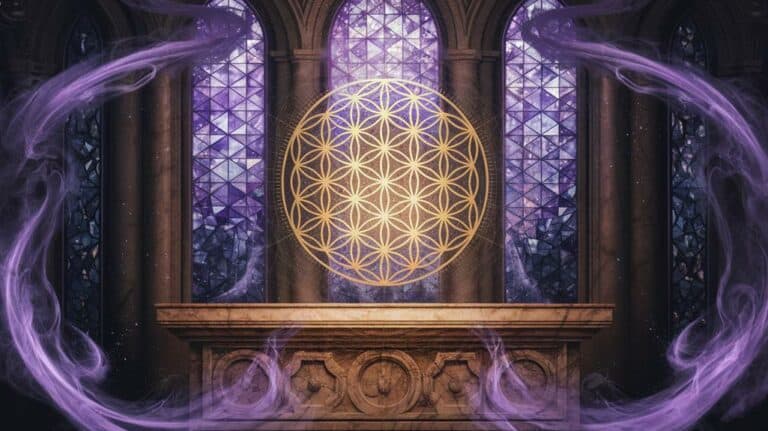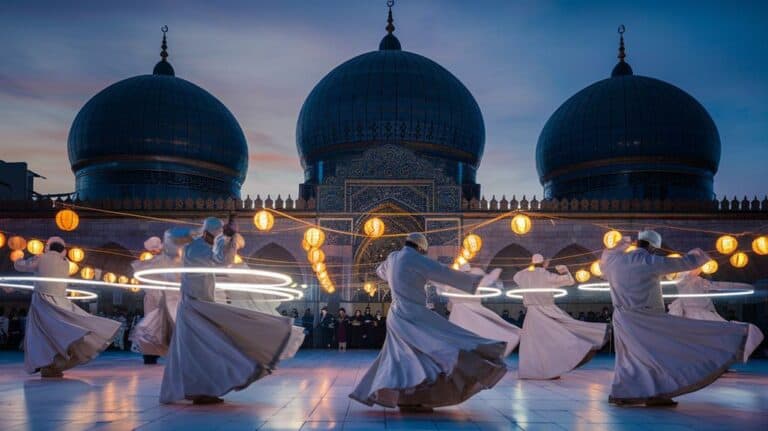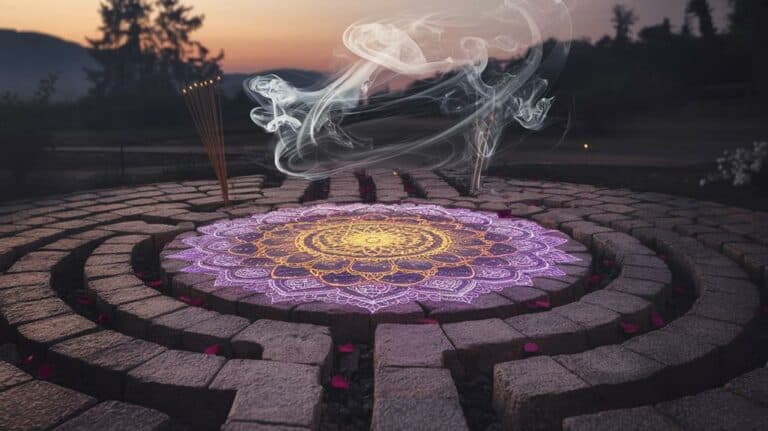11 Mystical Patterns in Sacred Architecture
When you step into a sacred space, you’re actually entering a carefully orchestrated symphony of geometric patterns that have guided spiritual architecture for millennia. You’ll find these mystical designs aren’t merely decorative—they’re purposeful encodings of universal wisdom, mathematical precision, and cosmic harmony. From the perfect spirals of Gothic cathedrals to the intricate star patterns of ancient mosques, these architectural elements speak a silent language that bridges the earthly and divine. While you might recognize some of these patterns instinctively, their deeper meanings and the profound ways they influence human consciousness await your discovery in the ancient traditions they represent.
The Golden Ratio
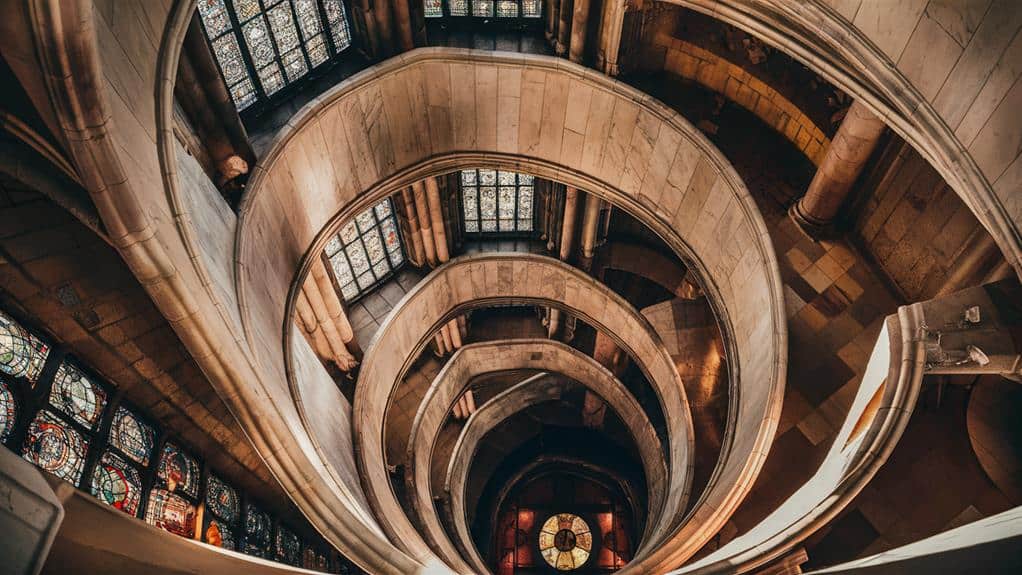
A perfect spiral unfolds in nature, from nautilus shells to galaxy arms, embodying a mathematical ratio of roughly 1.618 to 1. You’ll find this divine proportion, known as phi or the Golden Ratio, woven throughout sacred architecture across cultures and centuries.
As you step into grand cathedrals or ancient temples, you’re experiencing spaces designed to reflect this cosmic mathematics, creating an unconscious harmony that resonates with your very being.
When you trace the Golden Ratio in religious structures, you’ll discover it in the proportions of Notre-Dame’s façade, the dimensions of the Parthenon, and the spiraling minarets of Islamic mosques.
You’re witnessing a universal language of sacred geometry that transcends cultural boundaries and speaks directly to your soul’s innate understanding of divine order. The ratio appears in the placement of windows, the height of spires relative to their bases, and the proportions of ceremonial spaces.
This mathematical poetry isn’t merely aesthetic – it’s a deliberate attempt to bridge the earthly and divine spheres, creating spaces where you can feel physically aligned with the universe’s fundamental patterns.
Sacred Geometry of Mandalas
Deep within the heart of Eastern spiritual traditions, mandalas emerge as intricate geometric patterns that map out the cosmos in miniature form.
You’ll discover these sacred diagrams aren’t mere decorative art – they’re sophisticated mathematical expressions of universal principles that connect you to higher dimensions of consciousness.
When you study a mandala’s construction, you’ll notice how it revolves around a central point, expanding outward in concentric circles and squares that embody the fundamental patterns of creation.
Each layer represents a different aspect of existence, from the material world to the ethereal planes. You’ll find these sacred blueprints in temples across Asia, where their precise geometric relationships create powerful energy fields that transform ordinary space into sanctified ground.
As you trace a mandala’s pathways, you’re following the same divine proportions that govern galaxies and atomic structures.
The symmetry speaks to your soul in a language older than words – it’s a geometric meditation that aligns your inner architecture with universal order.
You’re not just observing these sacred patterns; you’re participating in an ancient practice that bridges the visible and invisible dimensions.
Gothic Rose Windows
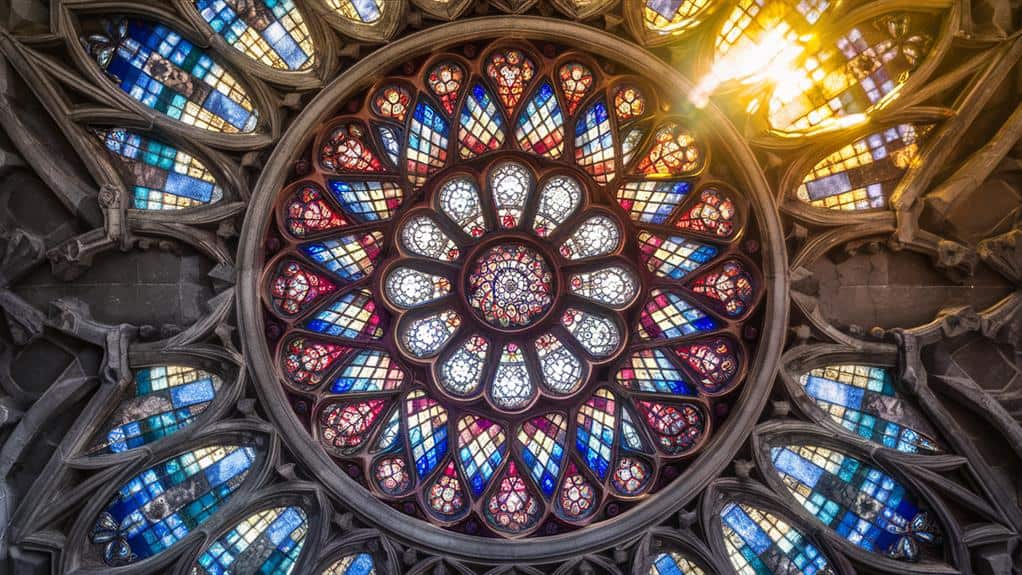
Radiant stone and stained glass unite in Gothic rose windows, forming wheel-like masterpieces that crown Europe’s medieval cathedrals. As you gaze upward, you’ll discover these circular windows aren’t merely decorative features—they’re spiritual portals designed to transform ordinary light into divine illumination.
Each intricate pattern draws your eye toward the center, mirroring your own journey toward spiritual truth.
You’ll find that medieval craftsmen didn’t create these windows by chance. Their geometric patterns express profound cosmological principles: the center represents divine unity while radiating lines and curves symbolize creation flowing outward from that sacred source.
When sunlight streams through the colored glass, you’re witnessing the same transformative spectacle that moved medieval worshippers—darkness giving way to enlightenment, multiplicity resolving into unity.
Today, as you stand beneath these ancient wheels of light, you’re connecting with centuries of seekers who’ve found inspiration in their sacred geometry.
The rose window’s message transcends time: you’re part of something larger than yourself, caught in an eternal dance between the finite and infinite, between earth and heaven.
Fibonacci Spirals in Design
Nautilus shells and unfurling ferns reveal nature’s own design secret: the Fibonacci spiral. You’ll find this mathematical wonder, where each number is the sum of the two before it, embedded within sacred architecture across continents and centuries.
When you’re standing beneath a dome that incorporates this divine proportion, you can’t help but feel connected to the universe’s underlying order.
As you explore religious structures worldwide, you’ll discover how architects have woven this sacred geometry into their designs – from spiral staircases in medieval monasteries to the sweeping curves of modern meditation spaces.
The spiral’s inherent balance draws your eye inward while simultaneously expanding your consciousness outward, creating a sense of infinite progression that mirrors spiritual growth.
You’re witnessing more than mere mathematical precision; you’re experiencing the bridge between rational design and mystical revelation.
In Islamic geometric patterns, Buddhist temples, and Renaissance churches, you’ll find these spirals directing your gaze heavenward, reminding you that you’re part of something vastly larger than yourself.
It’s a pattern that speaks to both your analytical mind and your seeking soul.
Islamic Geometric Star Patterns
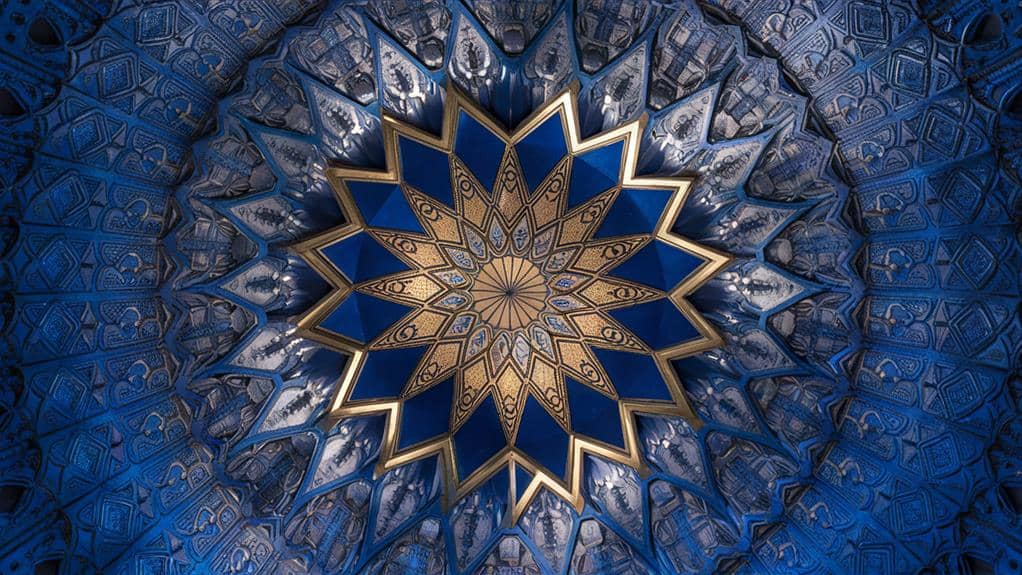
Mathematical harmony unfolds in Islamic geometric star patterns, where precise lines intersect to create intricate designs that extend infinitely in all directions.
You’ll find these mesmerizing configurations adorning the walls of ancient mosques and madrasas, where they serve as both artistic expression and spiritual meditation. As you trace the intricate paths with your eyes, you’re participating in a centuries-old tradition that transforms mathematical principles into sacred geometry.
In these patterns, you’ll discover that stars with six, eight, or twelve points emerge from careful geometric construction, reflecting the Islamic artisans’ deep understanding of circle division and symmetry.
You’re witnessing how they’ve masterfully avoided figurative representation while creating something profound – patterns that suggest the infinite nature of divine creation. When you study these designs closely, you’ll notice how smaller stars nest within larger ones, creating a rhythmic dance of light and shadow that draws your consciousness toward contemplation of the eternal.
These patterns aren’t just decorative elements; they’re visual prayers encoded in geometry, inviting you to reflect on your place in the vast cosmic order they represent.
Merkaba Sacred Architecture
The ancient concept of Merkaba architecture takes sacred geometry into another dimension, moving beyond two-dimensional patterns into three-dimensional forms that embody spiritual energy.
You’ll find this sacred architectural principle manifested in the form of two interlocking tetrahedra – one pointing upward toward the heavens, the other reaching downward toward Earth – creating a three-dimensional, six-pointed star that’s believed to generate powerful energy fields.
When you explore Merkaba-inspired buildings, you’ll discover how architects have integrated this sacred geometric form into modern structures through pyramidal shapes, hexagonal layouts, and ascending spiral patterns.
You’ll notice how the intersecting triangular forms create a sense of dynamic balance and movement, even within static structures. The principle extends beyond mere physical design – it’s meant to facilitate spiritual transformation by aligning earthly and celestial energies within the space you occupy.
In temples and meditation centers incorporating Merkaba geometry, you’ll experience how the balanced opposing forces create an energetic vortex that’s designed to enhance your connection to higher consciousness, making these spaces powerful catalysts for spiritual awakening.
Celtic Knots and Crosses
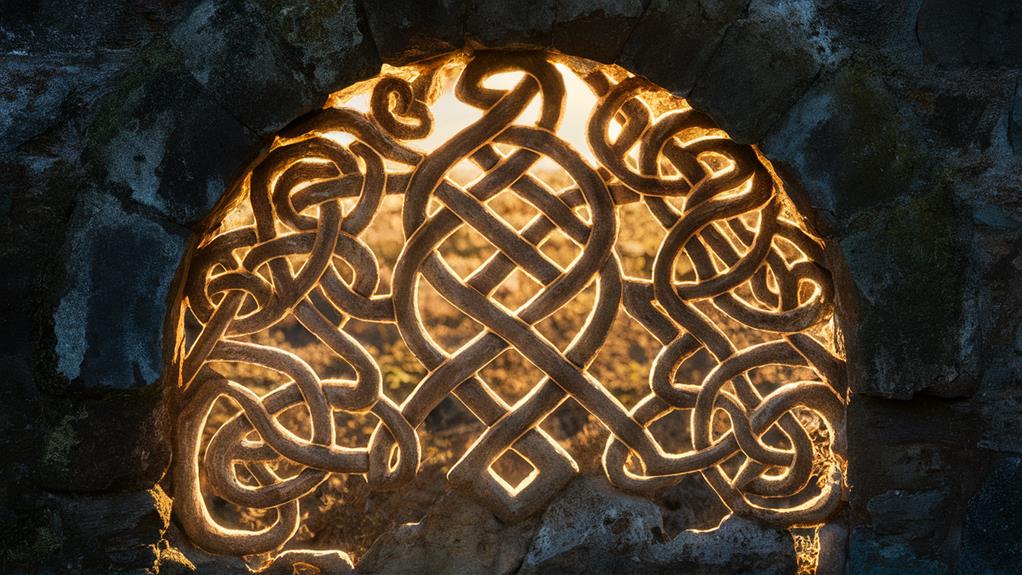
Ancient Celtic knots and crosses emerge as intricate architectural elements woven throughout sacred spaces, embodying both decorative artistry and profound spiritual symbolism. You’ll find these mesmerizing patterns adorning church walls, monastery doorways, and ceremonial stone markers, where they’ve served as spiritual waypoints for over a millennium.
When you trace these endless loops with your eyes, you’re participating in an ancient meditation on eternity and interconnectedness.
As you explore Celtic sacred spaces, you’ll discover how these knots represent the intricate weaving of earthly and divine domains. You’re witnessing a mathematical precision in the way each line crosses over and under, creating patterns that reflect the cosmos’ infinite nature.
The high crosses, standing sentinel in churchyards and sacred sites, combine these intricate knots with biblical scenes and pagan symbols. They’re not just religious markers – they’re bridges between worlds, where you’ll find the physical and spiritual domains intersecting.
In these designs, you’re encountering a visual language that speaks of humanity’s eternal search for meaning, expressed through an art form that continues to resonate across centuries.
Vesica Piscis
Moving beyond Celtic patterns, sacred geometry finds its purest expression in the Vesica Piscis – an elegant intersection of two equal circles where the center of each lies on the circumference of the other.
You’ll find this sacred symbol embedded throughout ecclesiastical architecture, from Gothic cathedral windows to altar designs, representing the intersection of heaven and earth, spirit and matter.
When you study the Vesica Piscis, you’ll discover it’s more than mere geometry – it’s a gateway to understanding universal proportions.
Within its form, you’ll uncover the divine ratio that governs the human body, plant growth, and cosmic structures. The pointed oval shape created by the intersection isn’t just aesthetically pleasing; it’s mathematically significant, generating the square root of 3 and the equilateral triangle.
You can trace this pattern’s influence in the floor plans of medieval churches, where builders used it to determine the proportions of naves and transepts.
It’s a reminder that you’re part of a grand architectural tradition that understood: sacred spaces aren’t just built – they’re conceived through the marriage of divine geometry and human inspiration.
Cosmic Labyrinths
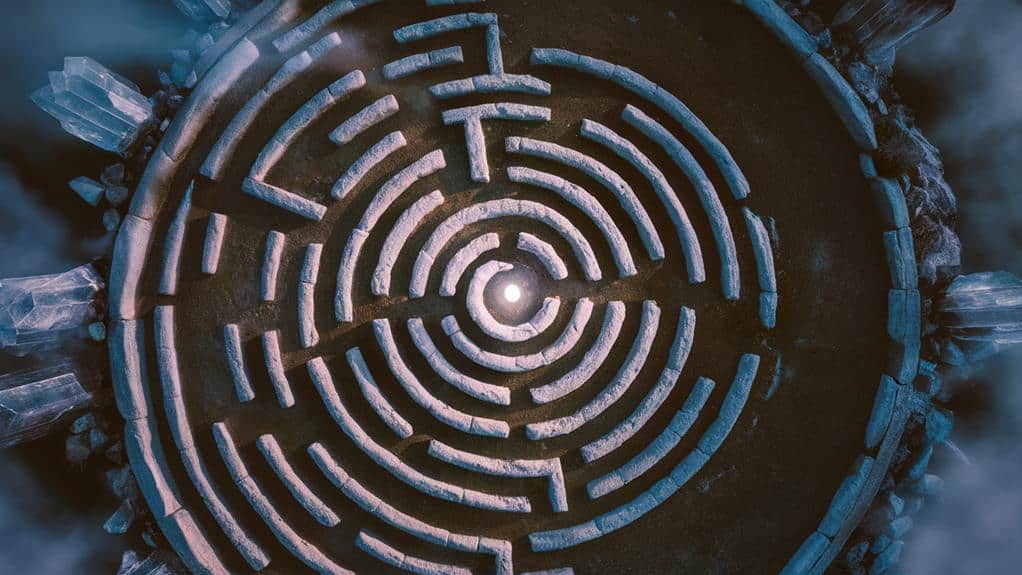
Sacred labyrinths weave their way through religious architecture across cultures, forming intricate pathways that mirror celestial movements and cosmic order.
You’ll discover these ancient patterns etched into cathedral floors, desert monuments, and temple courtyards, each inviting you to undertake a transformative journey toward enlightenment.
As you walk these sacred paths, you’ll notice how they reflect the ordered chaos of the universe – there’s no getting lost, only finding your way through a predetermined route that winds like a cosmic dance.
The labyrinth’s path often mirrors the apparent motion of planets, with turns and switchbacks that echo the retrograde movements of celestial bodies across the night sky.
You’re not just walking a maze when you enter these sacred spaces; you’re participating in a ritual that connects you to countless seekers who’ve traced these same steps throughout history.
The labyrinth’s center represents both journey’s end and beginning – a point where you’ll find yourself at the heart of sacred geometry, where terrestrial and celestial patterns converge in perfect harmony.
Sacred Proportional Systems
The mathematical precision found in sacred architecture extends far beyond labyrinthine patterns to encompass entire systems of divine proportion.
You’ll discover these sacred ratios embedded within the soaring heights of Gothic cathedrals, the perfectly balanced symmetry of Buddhist temples, and the intricate geometric patterns of Islamic mosques.
As you explore these architectural marvels, you’ll encounter the Golden Ratio (1:1.618), a proportion you’ll find in the Parthenon’s façade and Notre Dame’s elegant proportions.
You’re witnessing the same mathematical harmony that exists in nature’s spiraling shells and unfurling ferns, now translated into stone and space.
The sacred geometries of squares doubling into rectangles, circles transforming into octagonal towers, and triangles rising to heavenly spires aren’t random choices – they’re manifestations of universal mathematical truths.
When you stand within these spaces, you’re experiencing more than mere buildings; you’re inhabiting mathematical poetry written in three dimensions.
These proportional systems create a resonance between earthly and divine domains, allowing you to physically connect with the cosmic order that ancient builders understood so profoundly.
Temple Grid Patterns
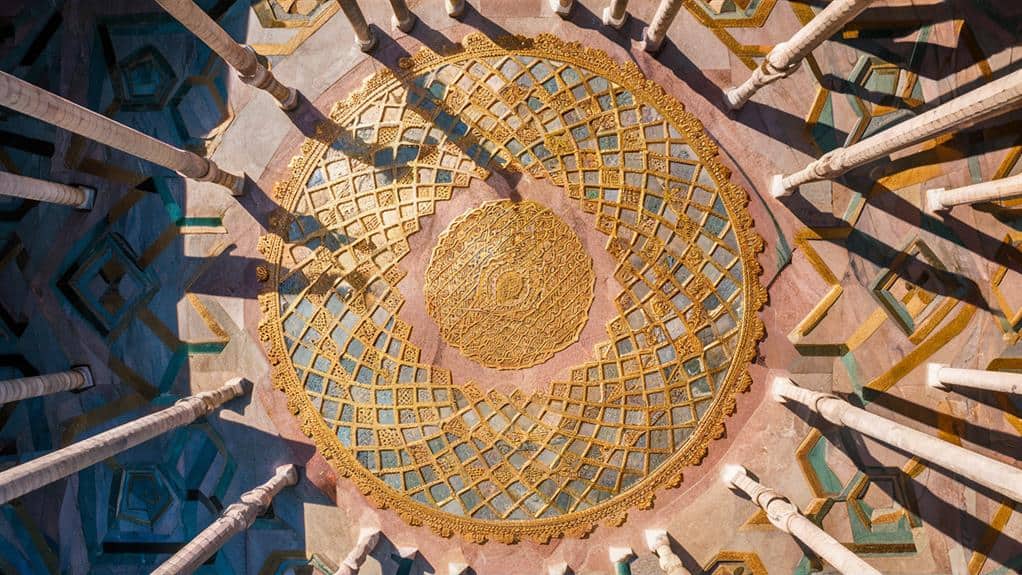
Ancient temple builders’ mastery of geometry manifests most clearly in their grid patterns – intricate networks of intersecting lines that form the foundational blueprint of sacred spaces.
When you study these grids, you’ll discover how they emerge from simple geometric shapes – circles, squares, and triangles – that overlap and intersect to create complex sacred frameworks.
You’ll find these mystical grid patterns across diverse cultures, from Hindu mandala templates to Gothic cathedral floor plans.
As you trace the lines, you’ll notice how they’re not just practical construction guides but cosmic maps that encode universal principles. The grid’s intersections often mark significant points where energy flows converge, creating what you’d recognize as altar locations, shrines, and meditation spaces.
What’s remarkable is how these patterns reflect celestial alignments – you can see how builders positioned key architectural elements along grid lines that mirror astronomical events.
You’ll understand why certain temples feel so powerful when you realize their grid patterns create resonant frequencies, transforming physical space into vessels of spiritual energy.
These aren’t just arbitrary designs; they’re sophisticated systems that connect earthly architecture to cosmic order.



